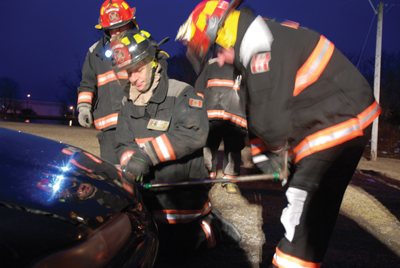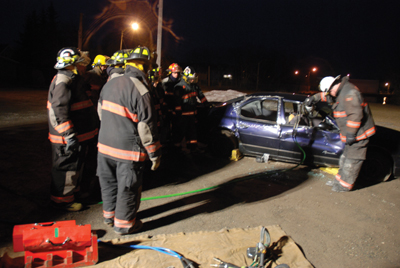
Features
Training
Trainer’s Corner – December 2012
If you are the go-to person for your department’s training, this column is a must-read.
In
a recent conversation with a firefighter, it was brought to my
attention that training nights often consist of the training officer
reading out of the IFSTA manual. Are you kidding? In this day and age,
having 14 firefighters sitting around a table while someone reads a
chapter on ventilation is unacceptable, if not criminal.
November 22, 2012
By Ed Brouwer
If you are the go-to person for your department’s training, this column is a must-read.
In a recent conversation with a firefighter, it was brought to my attention that training nights often consist of the training officer reading out of the IFSTA manual. Are you kidding? In this day and age, having 14 firefighters sitting around a table while someone reads a chapter on ventilation is unacceptable, if not criminal.
 |
|
| Fire department trainers should consider using tactics that work best for adults, including a combination of lectures and hands-on exercises.
|
|
Our firefighters deserve better training than someone reading for 45 minutes; the only thing worse is taking turns reading – no one listens because everyone is too busy trying to figure out if the paragraph they have to read contains any hard-to-pronounce words.
Reading to your fellow firefighters as a training technique does little, if anything, to enhance participants’ learning. We remember only 20 per cent of what a good speaker says to us for up to 10 days, as long as we hear no other new information. However, if after 10 days we have not integrated that message into our lives, we forget it almost completely. Confucius said, “I hear, I forget; I see, I remember; I do, I understand.”
Learning is the ability to gain knowledge or information by means of understanding or experience. According to the adult-learning website www.joe.org, adults have special needs as learners and these needs should be considered when planning training sessions. Limited lectures, problem solving, case studies, scenarios and discussion groups are all effective adult-learning techniques, according to the site.
An article on adult learning by professors and graduate students at a Louisiana State University outlines effective learning techniques:
- Lectures are useful for presenting up-to-date information, summarizing material and focusing on key concepts or ideas. Lectures should be used in 10- to 15-minute sections, spaced with active learning activities to re-energize participants for the next wave of information.
- Problem-based learning is an instructional strategy that encourages critical thinking and problem-solving skills.
- Case studies bring real-world problems into the training. Use of case studies can result in better retention, recall and use of learning outside the training.
- Role play is defined as an experience around a specific situation. The situations should be realistic and relevant. The most successful scenarios develop a skill.
- Discussion encourages students to discover solutions.
Do you learn better by seeing, hearing or acting out the information you receive? Actually, everybody learns by a mixture of methods, but one method or type is usually dominant in each person.
Respect the fact that your department members have different learning styles. There are three general learning styles: visual, auditory and kinesthetic.
Visual learners rely on pictures. They love graphs, diagrams and illustrations. Show me is their motto. You can best communicate with them by providing handouts or writing on the white board.
Auditory learners listen carefully to all sounds associated with the learning. Tell me is their motto. They will pay close attention to the sound of your voice and all of its subtle messages, and they will actively participate in discussions. You can best communicate with them by speaking clearly and asking questions.
Kinesthetic learners need to physically do something to understand it. Their motto is Let me do it. They want to actually touch what they’re learning. They are the ones who will get up and help you with role-playing. You can best communicate with them by involving volunteers and allowing them to practise what they’re learning.
Any activity that gets your firefighters involved helps them learn; activities also keep people energized and engaged.
 |
Part of your job as a trainer is to recognize teaching moments and use them. The continuing education section of the website www.about.com suggests that when a student says or does something that triggers a topic on your agenda, you should be flexible and teach it right then. If that would mess up your schedule, teach a bit about the subject and then move back to your plan.
The best instructors are positive and encouraging. Give your fellow firefighters time to respond when you ask a question. They may need a few moments to consider their answer. Recognize the contributions they make, even small ones. Give them words of encouragement whenever the opportunity arises. Most adults will rise to your expectations if you’re clear about them.
Genuine encouragement from one person to another, regardless of age, is a wonderful point of human interaction. This is your challenge as a teacher of adults. Beyond teaching your subject, you have the opportunity to inspire confidence and passion in another human being. That kind of teaching changes lives.
One can lack any of the qualities of a trainer and still be effective and successful, with one exception. That exception is the art of communication. It does not matter what you know about anything if you cannot communicate to your people.
Learning styles
People learn best when:
- They are assured that they are respected.
- They can see that what they are being offered is what they need.
- The session content is organized around problems with which they are actively concerned
- Their learning takes into account what they already know and builds on that.
People learn from repetition; people learn from repetition; people learn from repetition; people learn from repetition, and of course, people learn from repetition. So do you know how people learn?
Presenting Information
Lecturette:
- Organize information meaningfully.
- Include an introduction and a summary.
- Prepare interesting visual aids and interactive questions.
Brainstorming:
- Post the question.
- Record ideas and thoughts from the group.
- At the end, categorize the responses.
Buzz groups:
- Divide students into small groups.
- Assign a task or problem to the groups and set a time limit.
- Discuss each group’s findings.
Case studies:
- Write a real-life story (or download case studies regarding firefighter accidents or fatality reports).
- Pose questions that require solving and discuss responses.
Discussions:
- Create questions that support your teaching objectives.
- Promote involvement from all members of the group.
- Use in both large group settings and buzz groups.
Teaching tips
- Adequately prepare for each lesson. Your best instructional tool is preparedness!
- Study the lesson outline well before you have to present it.
- Study the lesson objectives. You must know the goals for the lesson.
- Preview any videos and test your equipment.
- Prepare visuals (flipcharts, flashcards, posters).
- Use your imagination and coloured markers.
- Prepare your transparencies or PowerPoint ahead of time.
- Select or create appropriate questions and skill tests.
- Use the three Ds: describe, demonstrate and do.
- Allow students time to touch, take apart and put back together the new equipment.
- Keep the lecture to a minimum!
- Maintain a sense of humour.
- Encourage with positive feedback!
- Do not belittle people or laugh at their questions or answers.
- If you are training volunteers, keep in mind that your members may have just finished eight hours of hard work, wolfed down supper and are now more ready to sleep than to learn. Take note, as well, that for the most part, your students are not going into the fire service for a career. Your task is great!
Each trainer is held accountable to the NFPA 1041 standard. There are critical additions to the 2012 edition of NFPA 1041, which include:
- An emphasis on safety in the learning environment.
- New coverage on distinguishing different methods and techniques of instruction.
- A new job-performance requirement on preparing requests for resources.
- A new job-performance requirement on scheduling single instructional sessions.
- Information on developing techniques to recognize cultural diversity, bias and discrimination when considering instruction, materials and learning environment.
- Information on how to identify the elements of methodologies in a technology-based society.
Keep it simple: At one recent training night, we did a quick lesson (20 minutes) on fire behaviour. We used emergency candles, matches, coat hangers and cotton swabs. We demonstrated radiant heat, convection and conduction, and we proved white smoke could ignite.
Ed Brouwer is the chief instructor for Canwest Fire in Osoyoos, B.C., and Greenwood Fire and Rescue. The 21-year veteran of the fire service is also a fire warden with the B.C. Ministry of Forests, a Wildland Urban Interface fire suppression instructor/evaluator and a fire-service chaplain. Contact Ed at aka-opa@hotmail.com
Print this page